Negotiation Simulation Role Play Project: MGT5ERN, Bundoora Bus
VerifiedAdded on 2023/05/28
|7
|1837
|484
Project
AI Summary
This assignment presents a role-play project simulating a workplace negotiation scenario. The student assumes the role of Sam Stickler, the HR manager of the Bundoora Bus Company, dealing with a drug testing policy and a positive test result for a bus driver, Casey Connor. The core issue revolves around the conflict between the company's policy, union representation, and the potential involvement of Fair Work Australia. The student outlines their desired outcomes, including avoiding Fair Work Australia intervention and modifying the policy to be more feasible for employees, while also considering the union representative's perspective and the employee's situation. The student plans to use techniques like anchoring with a draft agreement and seeking advice from the union representative to facilitate a mutually acceptable resolution. The document details the negotiation process, emphasizing the importance of preparation, maintaining a confident posture, active listening, and a commitment to the safety of passengers and the company's reputation. The student aims to find a solution that balances the needs of all parties involved, ensuring transparency and realistic approaches to the discussion. The assignment also includes references and a bibliography.
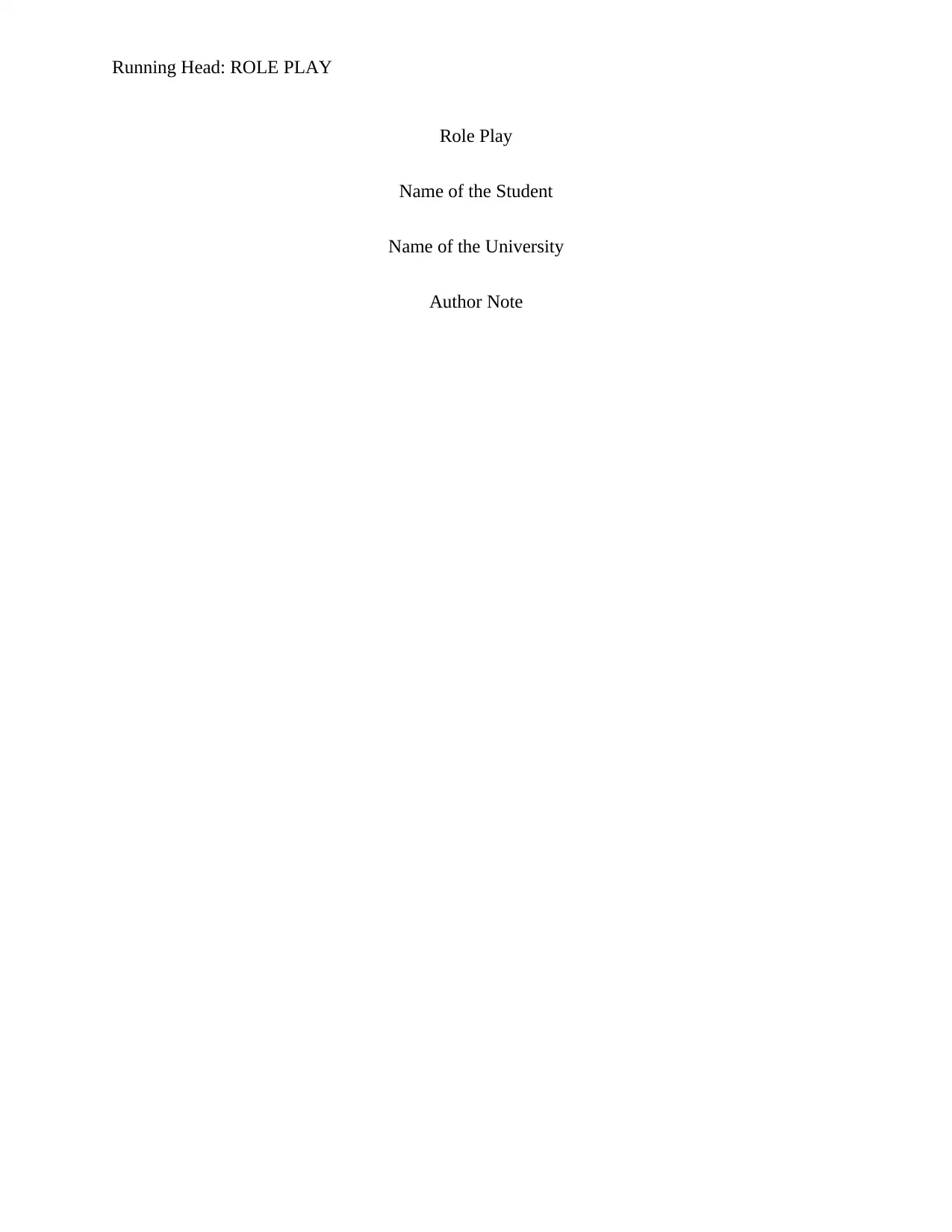
Running Head: ROLE PLAY
Role Play
Name of the Student
Name of the University
Author Note
Role Play
Name of the Student
Name of the University
Author Note
Paraphrase This Document
Need a fresh take? Get an instant paraphrase of this document with our AI Paraphraser
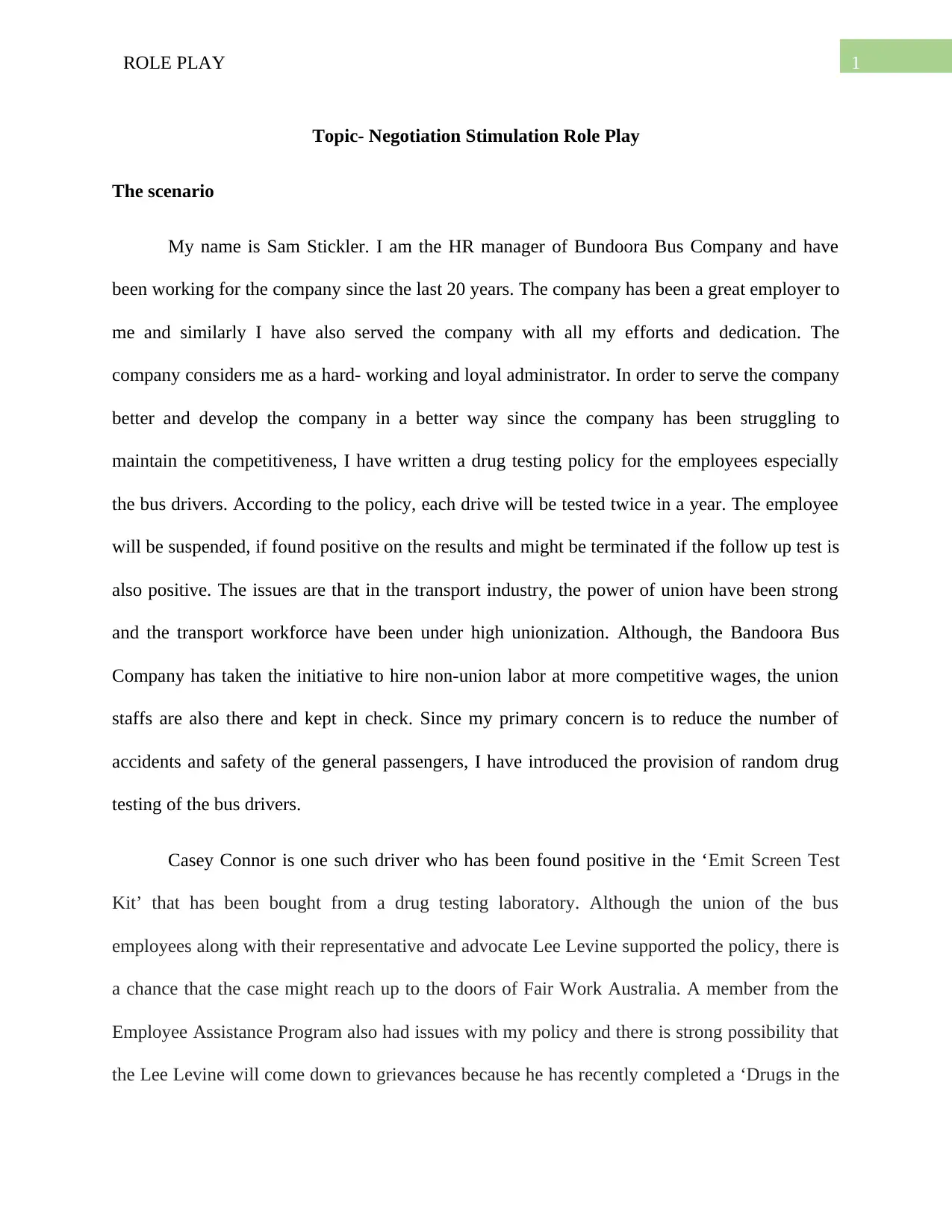
1ROLE PLAY
Topic- Negotiation Stimulation Role Play
The scenario
My name is Sam Stickler. I am the HR manager of Bundoora Bus Company and have
been working for the company since the last 20 years. The company has been a great employer to
me and similarly I have also served the company with all my efforts and dedication. The
company considers me as a hard- working and loyal administrator. In order to serve the company
better and develop the company in a better way since the company has been struggling to
maintain the competitiveness, I have written a drug testing policy for the employees especially
the bus drivers. According to the policy, each drive will be tested twice in a year. The employee
will be suspended, if found positive on the results and might be terminated if the follow up test is
also positive. The issues are that in the transport industry, the power of union have been strong
and the transport workforce have been under high unionization. Although, the Bandoora Bus
Company has taken the initiative to hire non-union labor at more competitive wages, the union
staffs are also there and kept in check. Since my primary concern is to reduce the number of
accidents and safety of the general passengers, I have introduced the provision of random drug
testing of the bus drivers.
Casey Connor is one such driver who has been found positive in the ‘Emit Screen Test
Kit’ that has been bought from a drug testing laboratory. Although the union of the bus
employees along with their representative and advocate Lee Levine supported the policy, there is
a chance that the case might reach up to the doors of Fair Work Australia. A member from the
Employee Assistance Program also had issues with my policy and there is strong possibility that
the Lee Levine will come down to grievances because he has recently completed a ‘Drugs in the
Topic- Negotiation Stimulation Role Play
The scenario
My name is Sam Stickler. I am the HR manager of Bundoora Bus Company and have
been working for the company since the last 20 years. The company has been a great employer to
me and similarly I have also served the company with all my efforts and dedication. The
company considers me as a hard- working and loyal administrator. In order to serve the company
better and develop the company in a better way since the company has been struggling to
maintain the competitiveness, I have written a drug testing policy for the employees especially
the bus drivers. According to the policy, each drive will be tested twice in a year. The employee
will be suspended, if found positive on the results and might be terminated if the follow up test is
also positive. The issues are that in the transport industry, the power of union have been strong
and the transport workforce have been under high unionization. Although, the Bandoora Bus
Company has taken the initiative to hire non-union labor at more competitive wages, the union
staffs are also there and kept in check. Since my primary concern is to reduce the number of
accidents and safety of the general passengers, I have introduced the provision of random drug
testing of the bus drivers.
Casey Connor is one such driver who has been found positive in the ‘Emit Screen Test
Kit’ that has been bought from a drug testing laboratory. Although the union of the bus
employees along with their representative and advocate Lee Levine supported the policy, there is
a chance that the case might reach up to the doors of Fair Work Australia. A member from the
Employee Assistance Program also had issues with my policy and there is strong possibility that
the Lee Levine will come down to grievances because he has recently completed a ‘Drugs in the
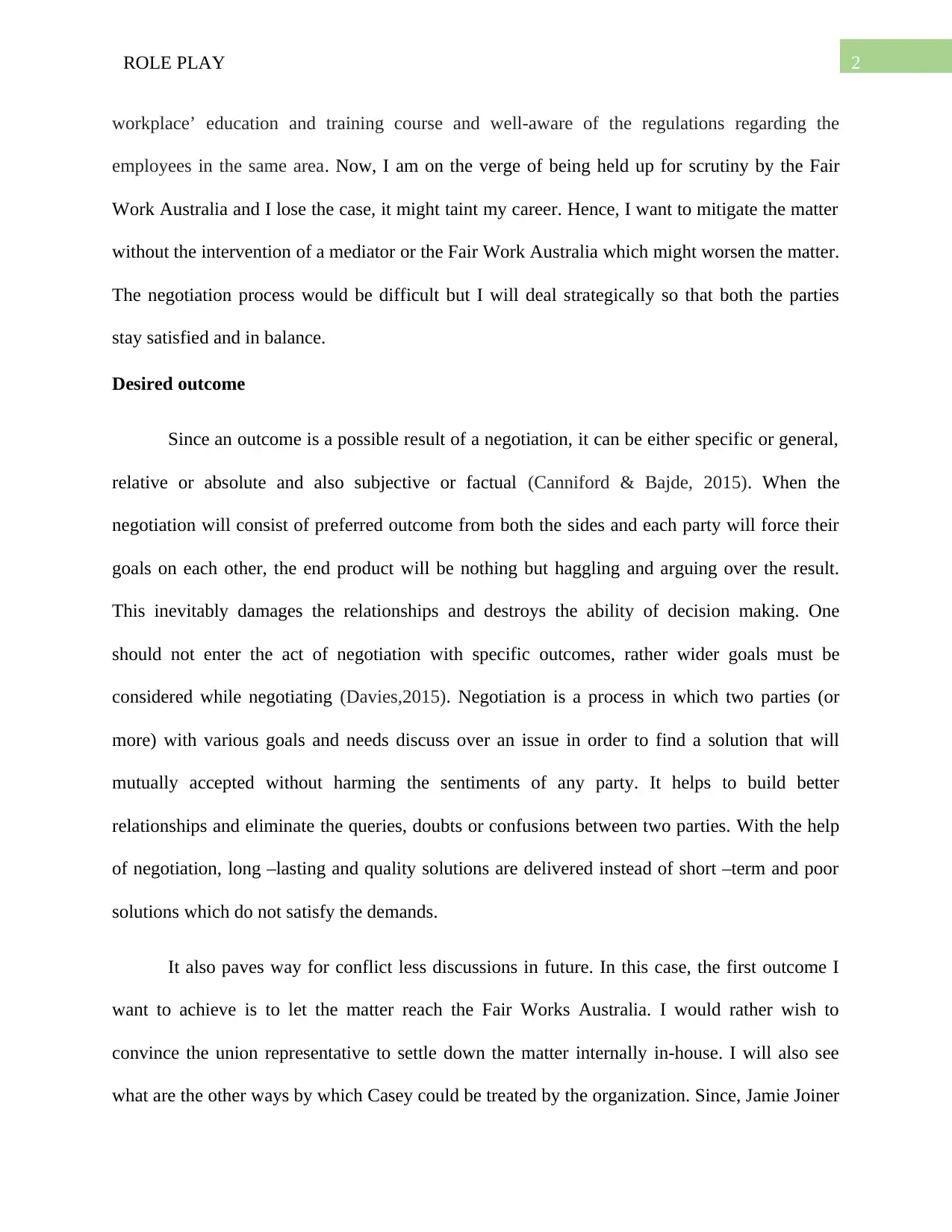
2ROLE PLAY
workplace’ education and training course and well-aware of the regulations regarding the
employees in the same area. Now, I am on the verge of being held up for scrutiny by the Fair
Work Australia and I lose the case, it might taint my career. Hence, I want to mitigate the matter
without the intervention of a mediator or the Fair Work Australia which might worsen the matter.
The negotiation process would be difficult but I will deal strategically so that both the parties
stay satisfied and in balance.
Desired outcome
Since an outcome is a possible result of a negotiation, it can be either specific or general,
relative or absolute and also subjective or factual (Canniford & Bajde, 2015). When the
negotiation will consist of preferred outcome from both the sides and each party will force their
goals on each other, the end product will be nothing but haggling and arguing over the result.
This inevitably damages the relationships and destroys the ability of decision making. One
should not enter the act of negotiation with specific outcomes, rather wider goals must be
considered while negotiating (Davies,2015). Negotiation is a process in which two parties (or
more) with various goals and needs discuss over an issue in order to find a solution that will
mutually accepted without harming the sentiments of any party. It helps to build better
relationships and eliminate the queries, doubts or confusions between two parties. With the help
of negotiation, long –lasting and quality solutions are delivered instead of short –term and poor
solutions which do not satisfy the demands.
It also paves way for conflict less discussions in future. In this case, the first outcome I
want to achieve is to let the matter reach the Fair Works Australia. I would rather wish to
convince the union representative to settle down the matter internally in-house. I will also see
what are the other ways by which Casey could be treated by the organization. Since, Jamie Joiner
workplace’ education and training course and well-aware of the regulations regarding the
employees in the same area. Now, I am on the verge of being held up for scrutiny by the Fair
Work Australia and I lose the case, it might taint my career. Hence, I want to mitigate the matter
without the intervention of a mediator or the Fair Work Australia which might worsen the matter.
The negotiation process would be difficult but I will deal strategically so that both the parties
stay satisfied and in balance.
Desired outcome
Since an outcome is a possible result of a negotiation, it can be either specific or general,
relative or absolute and also subjective or factual (Canniford & Bajde, 2015). When the
negotiation will consist of preferred outcome from both the sides and each party will force their
goals on each other, the end product will be nothing but haggling and arguing over the result.
This inevitably damages the relationships and destroys the ability of decision making. One
should not enter the act of negotiation with specific outcomes, rather wider goals must be
considered while negotiating (Davies,2015). Negotiation is a process in which two parties (or
more) with various goals and needs discuss over an issue in order to find a solution that will
mutually accepted without harming the sentiments of any party. It helps to build better
relationships and eliminate the queries, doubts or confusions between two parties. With the help
of negotiation, long –lasting and quality solutions are delivered instead of short –term and poor
solutions which do not satisfy the demands.
It also paves way for conflict less discussions in future. In this case, the first outcome I
want to achieve is to let the matter reach the Fair Works Australia. I would rather wish to
convince the union representative to settle down the matter internally in-house. I will also see
what are the other ways by which Casey could be treated by the organization. Since, Jamie Joiner
⊘ This is a preview!⊘
Do you want full access?
Subscribe today to unlock all pages.

Trusted by 1+ million students worldwide
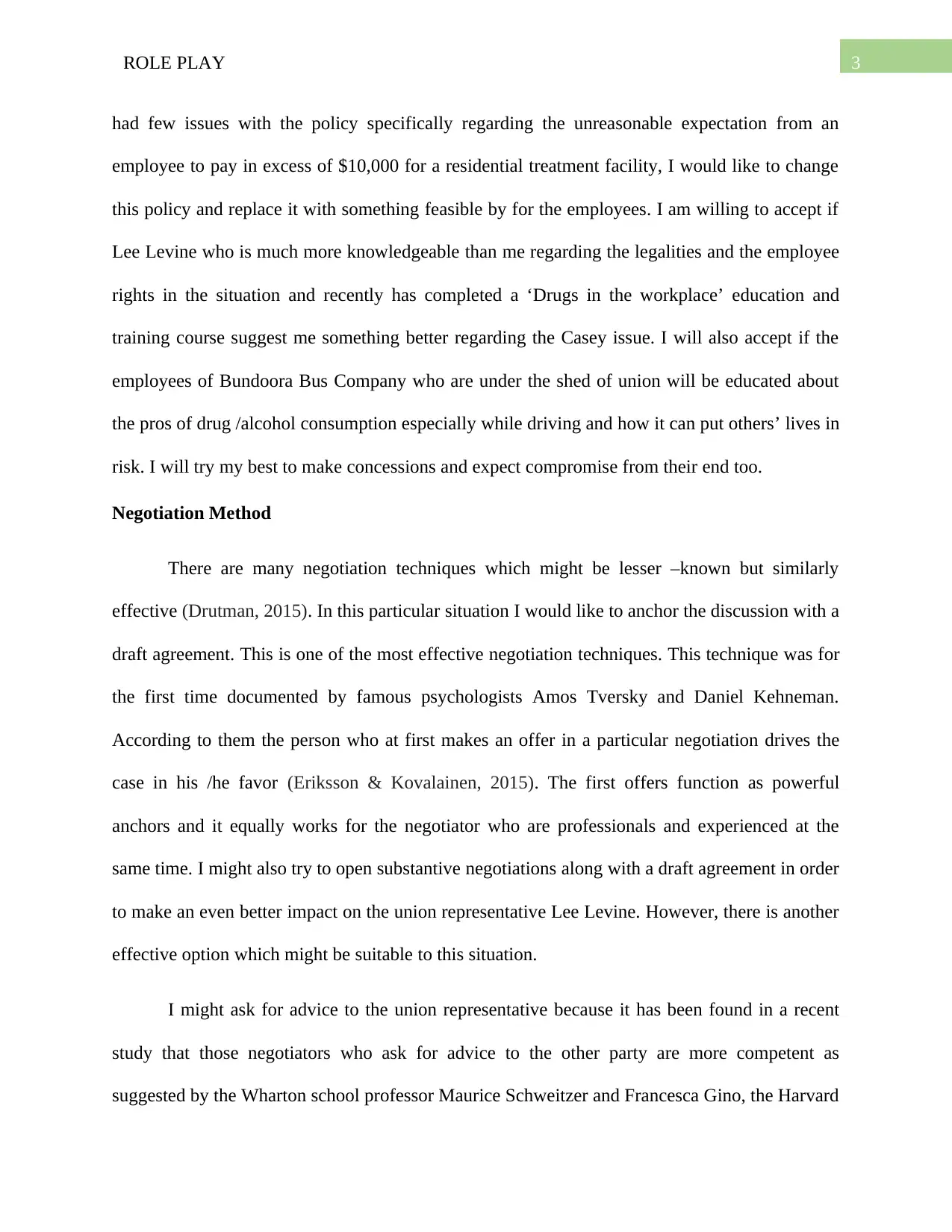
3ROLE PLAY
had few issues with the policy specifically regarding the unreasonable expectation from an
employee to pay in excess of $10,000 for a residential treatment facility, I would like to change
this policy and replace it with something feasible by for the employees. I am willing to accept if
Lee Levine who is much more knowledgeable than me regarding the legalities and the employee
rights in the situation and recently has completed a ‘Drugs in the workplace’ education and
training course suggest me something better regarding the Casey issue. I will also accept if the
employees of Bundoora Bus Company who are under the shed of union will be educated about
the pros of drug /alcohol consumption especially while driving and how it can put others’ lives in
risk. I will try my best to make concessions and expect compromise from their end too.
Negotiation Method
There are many negotiation techniques which might be lesser –known but similarly
effective (Drutman, 2015). In this particular situation I would like to anchor the discussion with a
draft agreement. This is one of the most effective negotiation techniques. This technique was for
the first time documented by famous psychologists Amos Tversky and Daniel Kehneman.
According to them the person who at first makes an offer in a particular negotiation drives the
case in his /he favor (Eriksson & Kovalainen, 2015). The first offers function as powerful
anchors and it equally works for the negotiator who are professionals and experienced at the
same time. I might also try to open substantive negotiations along with a draft agreement in order
to make an even better impact on the union representative Lee Levine. However, there is another
effective option which might be suitable to this situation.
I might ask for advice to the union representative because it has been found in a recent
study that those negotiators who ask for advice to the other party are more competent as
suggested by the Wharton school professor Maurice Schweitzer and Francesca Gino, the Harvard
had few issues with the policy specifically regarding the unreasonable expectation from an
employee to pay in excess of $10,000 for a residential treatment facility, I would like to change
this policy and replace it with something feasible by for the employees. I am willing to accept if
Lee Levine who is much more knowledgeable than me regarding the legalities and the employee
rights in the situation and recently has completed a ‘Drugs in the workplace’ education and
training course suggest me something better regarding the Casey issue. I will also accept if the
employees of Bundoora Bus Company who are under the shed of union will be educated about
the pros of drug /alcohol consumption especially while driving and how it can put others’ lives in
risk. I will try my best to make concessions and expect compromise from their end too.
Negotiation Method
There are many negotiation techniques which might be lesser –known but similarly
effective (Drutman, 2015). In this particular situation I would like to anchor the discussion with a
draft agreement. This is one of the most effective negotiation techniques. This technique was for
the first time documented by famous psychologists Amos Tversky and Daniel Kehneman.
According to them the person who at first makes an offer in a particular negotiation drives the
case in his /he favor (Eriksson & Kovalainen, 2015). The first offers function as powerful
anchors and it equally works for the negotiator who are professionals and experienced at the
same time. I might also try to open substantive negotiations along with a draft agreement in order
to make an even better impact on the union representative Lee Levine. However, there is another
effective option which might be suitable to this situation.
I might ask for advice to the union representative because it has been found in a recent
study that those negotiators who ask for advice to the other party are more competent as
suggested by the Wharton school professor Maurice Schweitzer and Francesca Gino, the Harvard
Paraphrase This Document
Need a fresh take? Get an instant paraphrase of this document with our AI Paraphraser
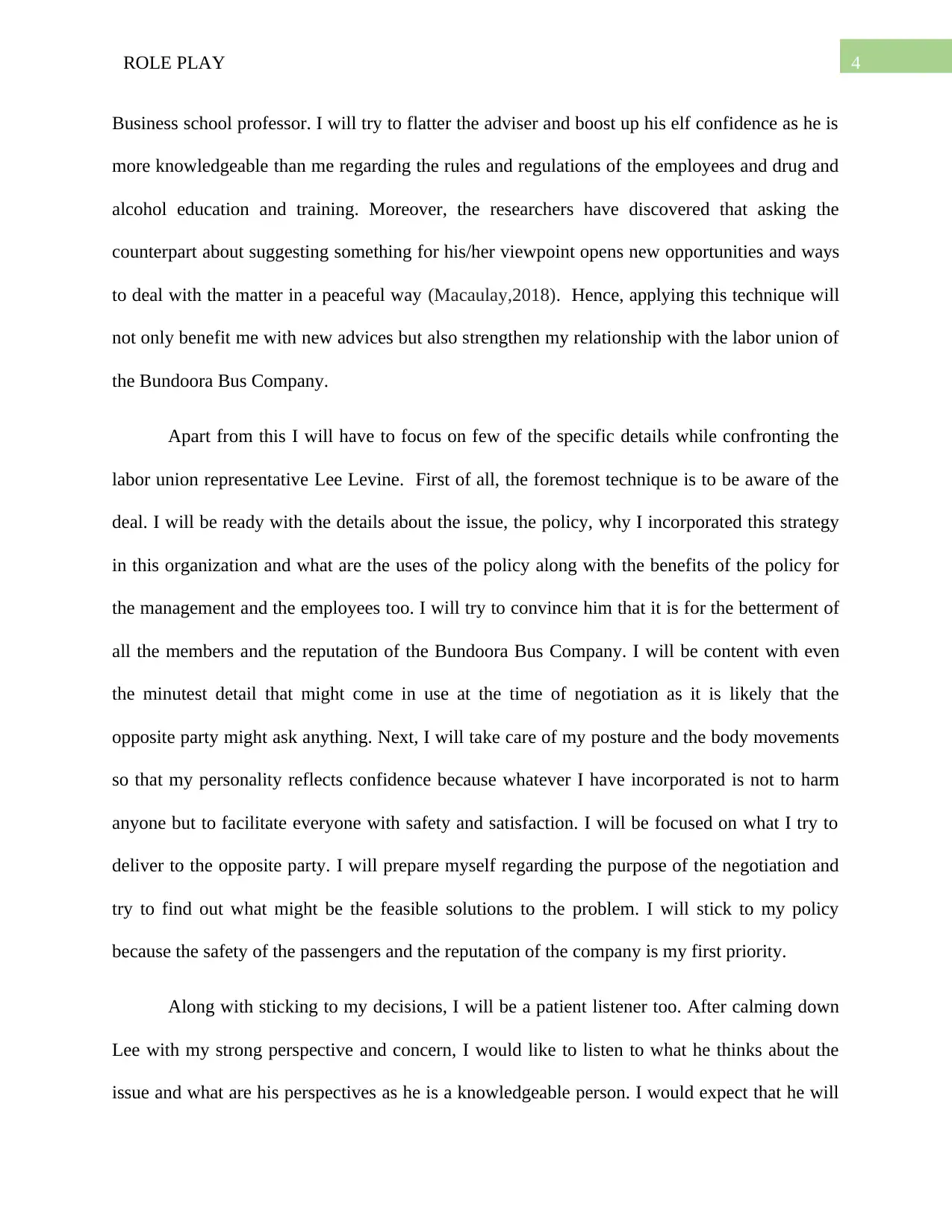
4ROLE PLAY
Business school professor. I will try to flatter the adviser and boost up his elf confidence as he is
more knowledgeable than me regarding the rules and regulations of the employees and drug and
alcohol education and training. Moreover, the researchers have discovered that asking the
counterpart about suggesting something for his/her viewpoint opens new opportunities and ways
to deal with the matter in a peaceful way (Macaulay,2018). Hence, applying this technique will
not only benefit me with new advices but also strengthen my relationship with the labor union of
the Bundoora Bus Company.
Apart from this I will have to focus on few of the specific details while confronting the
labor union representative Lee Levine. First of all, the foremost technique is to be aware of the
deal. I will be ready with the details about the issue, the policy, why I incorporated this strategy
in this organization and what are the uses of the policy along with the benefits of the policy for
the management and the employees too. I will try to convince him that it is for the betterment of
all the members and the reputation of the Bundoora Bus Company. I will be content with even
the minutest detail that might come in use at the time of negotiation as it is likely that the
opposite party might ask anything. Next, I will take care of my posture and the body movements
so that my personality reflects confidence because whatever I have incorporated is not to harm
anyone but to facilitate everyone with safety and satisfaction. I will be focused on what I try to
deliver to the opposite party. I will prepare myself regarding the purpose of the negotiation and
try to find out what might be the feasible solutions to the problem. I will stick to my policy
because the safety of the passengers and the reputation of the company is my first priority.
Along with sticking to my decisions, I will be a patient listener too. After calming down
Lee with my strong perspective and concern, I would like to listen to what he thinks about the
issue and what are his perspectives as he is a knowledgeable person. I would expect that he will
Business school professor. I will try to flatter the adviser and boost up his elf confidence as he is
more knowledgeable than me regarding the rules and regulations of the employees and drug and
alcohol education and training. Moreover, the researchers have discovered that asking the
counterpart about suggesting something for his/her viewpoint opens new opportunities and ways
to deal with the matter in a peaceful way (Macaulay,2018). Hence, applying this technique will
not only benefit me with new advices but also strengthen my relationship with the labor union of
the Bundoora Bus Company.
Apart from this I will have to focus on few of the specific details while confronting the
labor union representative Lee Levine. First of all, the foremost technique is to be aware of the
deal. I will be ready with the details about the issue, the policy, why I incorporated this strategy
in this organization and what are the uses of the policy along with the benefits of the policy for
the management and the employees too. I will try to convince him that it is for the betterment of
all the members and the reputation of the Bundoora Bus Company. I will be content with even
the minutest detail that might come in use at the time of negotiation as it is likely that the
opposite party might ask anything. Next, I will take care of my posture and the body movements
so that my personality reflects confidence because whatever I have incorporated is not to harm
anyone but to facilitate everyone with safety and satisfaction. I will be focused on what I try to
deliver to the opposite party. I will prepare myself regarding the purpose of the negotiation and
try to find out what might be the feasible solutions to the problem. I will stick to my policy
because the safety of the passengers and the reputation of the company is my first priority.
Along with sticking to my decisions, I will be a patient listener too. After calming down
Lee with my strong perspective and concern, I would like to listen to what he thinks about the
issue and what are his perspectives as he is a knowledgeable person. I would expect that he will
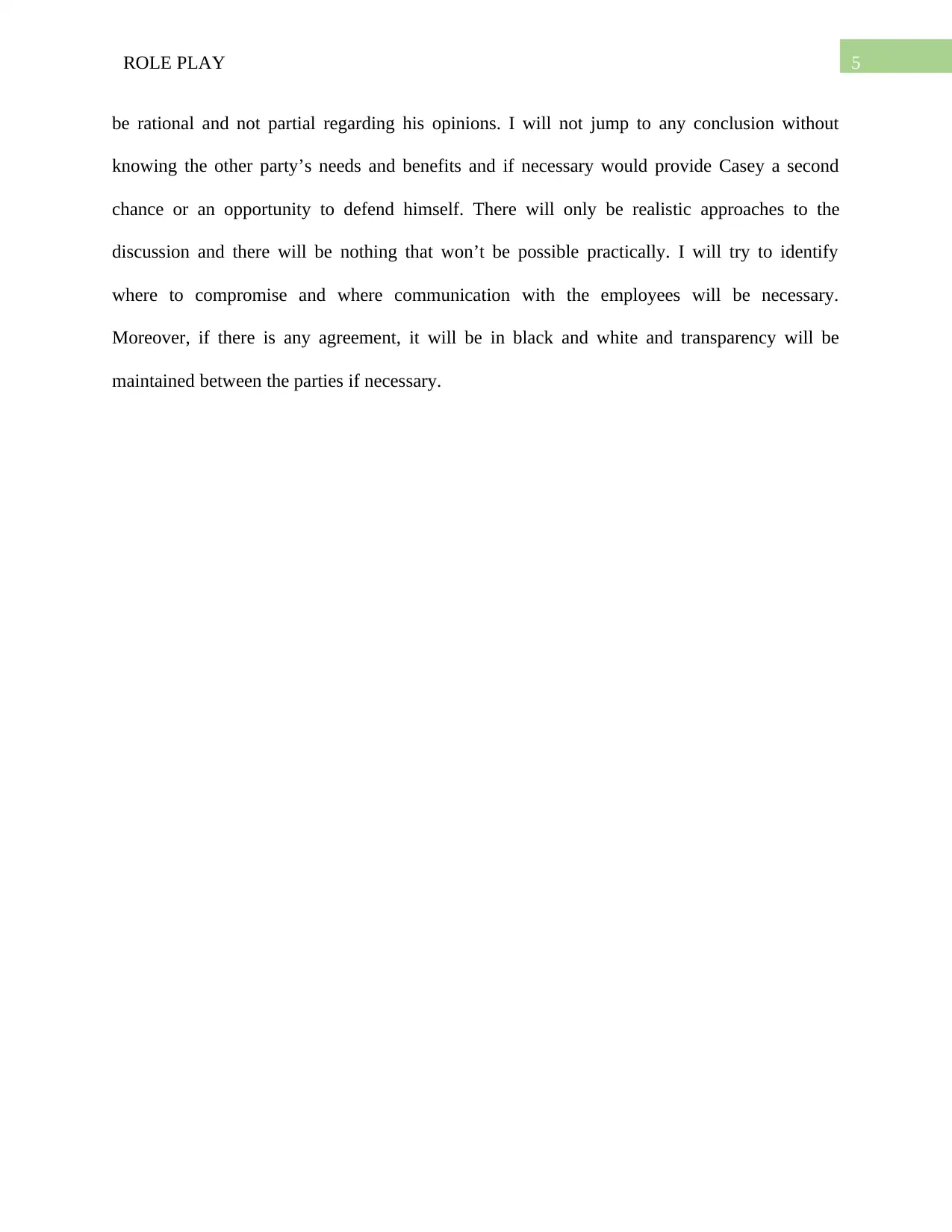
5ROLE PLAY
be rational and not partial regarding his opinions. I will not jump to any conclusion without
knowing the other party’s needs and benefits and if necessary would provide Casey a second
chance or an opportunity to defend himself. There will only be realistic approaches to the
discussion and there will be nothing that won’t be possible practically. I will try to identify
where to compromise and where communication with the employees will be necessary.
Moreover, if there is any agreement, it will be in black and white and transparency will be
maintained between the parties if necessary.
be rational and not partial regarding his opinions. I will not jump to any conclusion without
knowing the other party’s needs and benefits and if necessary would provide Casey a second
chance or an opportunity to defend himself. There will only be realistic approaches to the
discussion and there will be nothing that won’t be possible practically. I will try to identify
where to compromise and where communication with the employees will be necessary.
Moreover, if there is any agreement, it will be in black and white and transparency will be
maintained between the parties if necessary.
⊘ This is a preview!⊘
Do you want full access?
Subscribe today to unlock all pages.

Trusted by 1+ million students worldwide
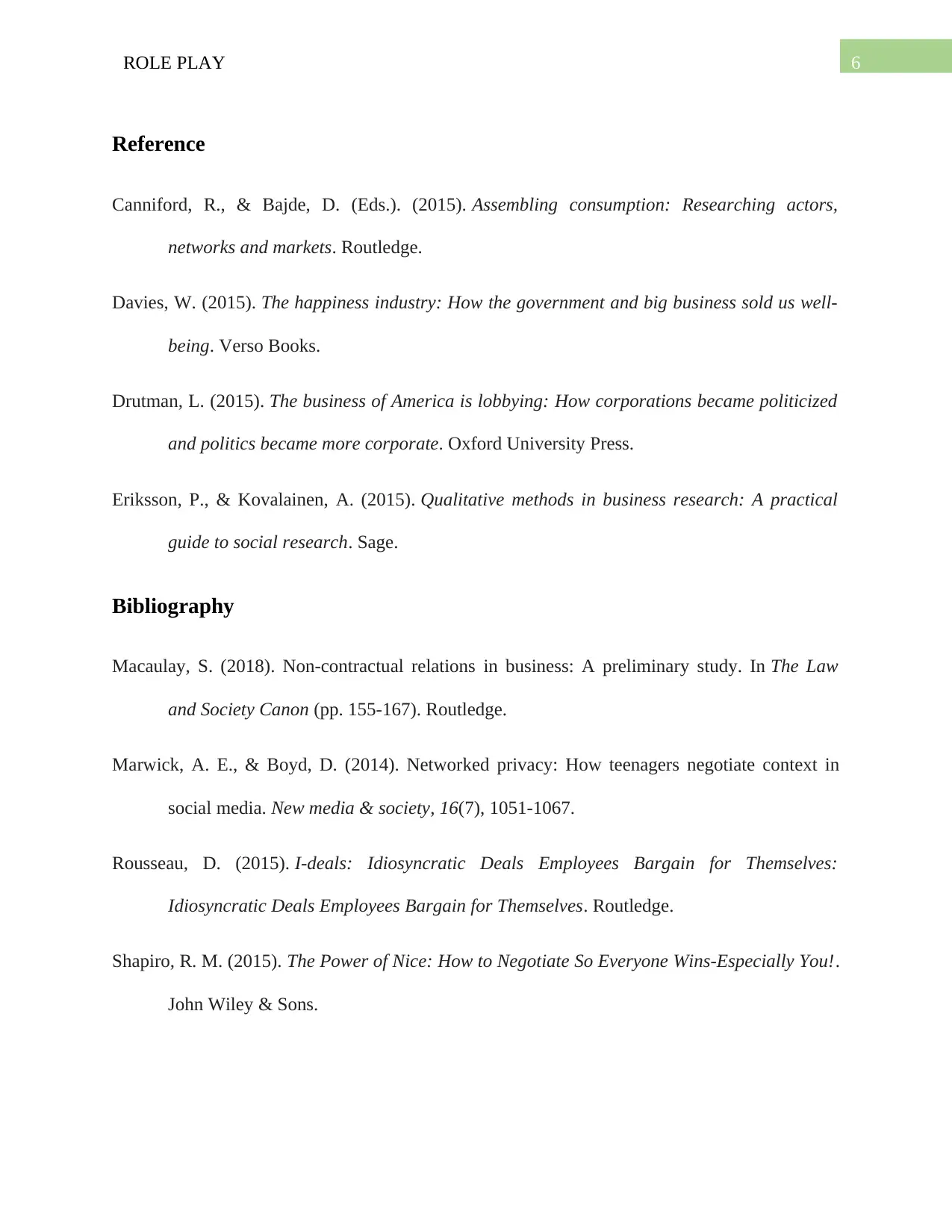
6ROLE PLAY
Reference
Canniford, R., & Bajde, D. (Eds.). (2015). Assembling consumption: Researching actors,
networks and markets. Routledge.
Davies, W. (2015). The happiness industry: How the government and big business sold us well-
being. Verso Books.
Drutman, L. (2015). The business of America is lobbying: How corporations became politicized
and politics became more corporate. Oxford University Press.
Eriksson, P., & Kovalainen, A. (2015). Qualitative methods in business research: A practical
guide to social research. Sage.
Bibliography
Macaulay, S. (2018). Non-contractual relations in business: A preliminary study. In The Law
and Society Canon (pp. 155-167). Routledge.
Marwick, A. E., & Boyd, D. (2014). Networked privacy: How teenagers negotiate context in
social media. New media & society, 16(7), 1051-1067.
Rousseau, D. (2015). I-deals: Idiosyncratic Deals Employees Bargain for Themselves:
Idiosyncratic Deals Employees Bargain for Themselves. Routledge.
Shapiro, R. M. (2015). The Power of Nice: How to Negotiate So Everyone Wins-Especially You!.
John Wiley & Sons.
Reference
Canniford, R., & Bajde, D. (Eds.). (2015). Assembling consumption: Researching actors,
networks and markets. Routledge.
Davies, W. (2015). The happiness industry: How the government and big business sold us well-
being. Verso Books.
Drutman, L. (2015). The business of America is lobbying: How corporations became politicized
and politics became more corporate. Oxford University Press.
Eriksson, P., & Kovalainen, A. (2015). Qualitative methods in business research: A practical
guide to social research. Sage.
Bibliography
Macaulay, S. (2018). Non-contractual relations in business: A preliminary study. In The Law
and Society Canon (pp. 155-167). Routledge.
Marwick, A. E., & Boyd, D. (2014). Networked privacy: How teenagers negotiate context in
social media. New media & society, 16(7), 1051-1067.
Rousseau, D. (2015). I-deals: Idiosyncratic Deals Employees Bargain for Themselves:
Idiosyncratic Deals Employees Bargain for Themselves. Routledge.
Shapiro, R. M. (2015). The Power of Nice: How to Negotiate So Everyone Wins-Especially You!.
John Wiley & Sons.
1 out of 7
Related Documents
Your All-in-One AI-Powered Toolkit for Academic Success.
+13062052269
info@desklib.com
Available 24*7 on WhatsApp / Email
![[object Object]](/_next/static/media/star-bottom.7253800d.svg)
Unlock your academic potential
Copyright © 2020–2025 A2Z Services. All Rights Reserved. Developed and managed by ZUCOL.




